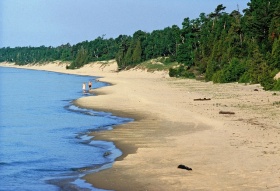Trails: Ski Trails POOR. Hiking trail icy, especially on bridges.
Sometimes, an insignificant chore can bring great joy. At Crossroads at Big Creek, that little chore is adjusting the timer on the parking lot lights. It’s still winter, but the darkest month is over. Days are becoming perceptively longer.
Winter has some good qualities. The cold is absolutely necessary in the life cycle of many plants. Snow is pretty, especially when it is deep enough for skiing. And the raccoons haven’t trashed our birdfeeders lately.
Where are the raccoons? Last fall, they were out on the deck almost every night, stealing birdseed and fighting with each other. Raccooons can be really testy, especially when they are hungry. In fall, they always are hungry, especially for carbohydrates. Consequently, before winter, raccoons really pack on the pounds.
Raccoons in the southern states say active all year, but in the Great Lakes region, when the days get short, raccoons find a den and start napping. Young raccoons may curl up with their mothers in tree cavities or deserted burrows (or sometimes, even occupied burrows) or perhaps, human-made structures. 28 degrees seems to be the temperature of decision. Higher than 28 degrees and raccoons wander at night. Below that, they just curl up and go back to sleep, living off their stored fat.
By midwinter, males may wander about in search of mates, and raccoons eventually get acclimatized to cold weather, but for the most part, there is real survival value in curling up and sleeping.
So….when days get shorter in fall, raccoons get grumpy, they crave and eat carbohydrates, they gain weight, and they sleep more.
That list sounds somehow so familiar….and perhaps it should. It is the list of symptoms for S.A.D. …Seasonal Affective Disorder. Researchers are still trying to determine the causes of S.A.D. But because it rarely is seen in the tropics or southern states, and because becomes increasingly more common, especially in women, the farther north one spends the winter, S.A.D. seems to be a response to the lack of sunlight.
Remember how you feel…..say, walking along the sunny shoreline at Whitefish Dunes State Park in midsummer. Compare that feeling to your mood on an overcast day in the bleak midwinter. Apparently, sunlight stimulates the production of feel-good hormones.
Conversely, lack of sunlight seems to trigger moodiness, weight gain, and fatigue. Presumably, for our early ancestors, these condition had survival value. In the late fall and winter, when it was dark, cold and food was scarce, people conserved energy by crawling into their caves to sleep and wait it out until spring.
If this behavior is part of our genetic makeup, it might explain why in winter, some people slow down and gain weight. Unfortunately, in our modern society, most of us would prefer to be slender and energetic. For an estimated 10 million Americans, S.A.D., Seasonal Affective Disorder, can be debilitating.
On Wednesday, Janaury 28, the Door County Public Health Department Mental Health Focus Group will present a free community event “Beat the Winter Blues–Don’t be S.A.D. this Winter.” starting at 6:00 with a Resource Fair. From 6:30-7:30, a presentation by Ann Athorp-Kresh, Phd of Bay Counceling Clinic will be offered in the lecture hall. A Question and Answer session will follow the presentation.
Even without the program, we at Crossroads know that a good dose of morning sunshine along with some exercise can be mood elevating—-maybe not a summer jaunt to The Dunes, but helpful. There is far more to Whitefish Dunes than a sunny beach with lots of sand, and if you haven’t been there for a while, you will find the park looks different.
 On Tuesday, January 27 at 7:00, the Master Gardeners will present the program: . “Evil Weevils and White Fluff- How Two Invasives Changed One Park”Carolyn Rock, Wisconsin DNR Natural Resource Educator, will offer an intimate look at how two invasive species have recently affected Whitefish Dunes State Park. She will review how an invasive weevil is threatening extinction of the dune thistle and describe how the park’s forest will change because of beech bark disease. Participants will discover the ongoing research of the thistle and develop a greater understanding of the ecological and management challenges the park faces with the beech bark. The programs is free and open to the public.
On Tuesday, January 27 at 7:00, the Master Gardeners will present the program: . “Evil Weevils and White Fluff- How Two Invasives Changed One Park”Carolyn Rock, Wisconsin DNR Natural Resource Educator, will offer an intimate look at how two invasive species have recently affected Whitefish Dunes State Park. She will review how an invasive weevil is threatening extinction of the dune thistle and describe how the park’s forest will change because of beech bark disease. Participants will discover the ongoing research of the thistle and develop a greater understanding of the ecological and management challenges the park faces with the beech bark. The programs is free and open to the public.
For those hoping to increase their exposure to full-spectrum light, our hiking and ski trails always are open and on Thursdays, Saturdays and Sundays, from 1:00-3:30 our volunteers will loan you winter recreation equipment as a part of our Ski For Free program.
Crossroads at Big Creek is a donor-supported preserve offering programs for learners of all ages in science, history and the environment. The Collins Learning Center,
located at 2041 Michigan, is open daily 2:00-4:30 and during scheduled events. Trails are always open, but designated ski trails are for skiing only. Hikers, dog walker, bikers, and those on snow shoes are asked to use the hiking trails.


